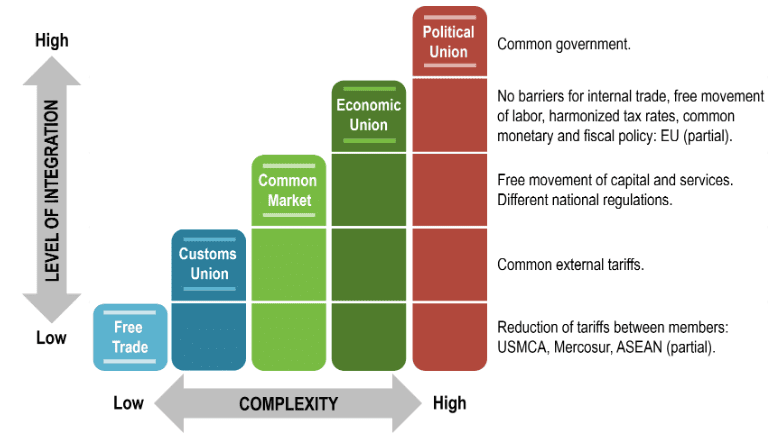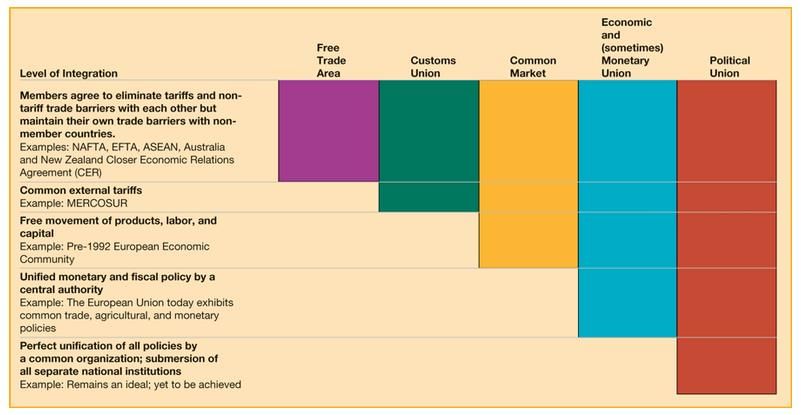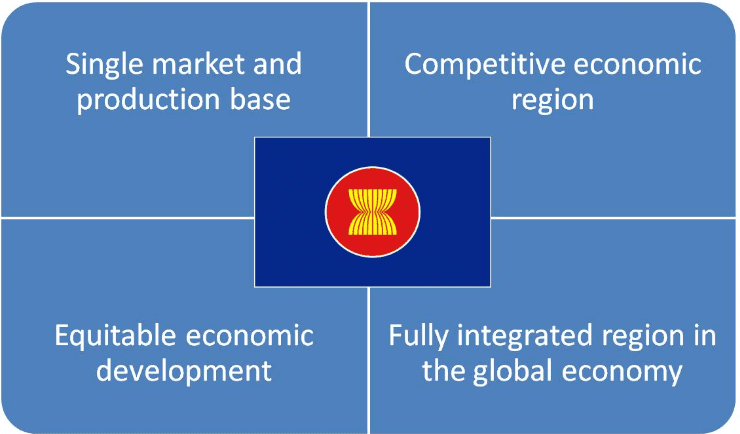Regional Economic Integration | Crash Course for UGC NET Commerce PDF Download
Regional Economic Integration
Regional economic integration refers to the process where countries within a specific geographic area work together to reduce trade barriers, facilitate the movement of assets and labor, and foster closer economic ties. The ultimate aim is to enhance economic prosperity and cooperation within the region.
Types of Regional Economic Integration

Regional economic integration can be categorized into different levels:
- Free Trade Area: Member countries eliminate tariffs and other trade barriers on goods traded among them but maintain their own external tariffs.
- Customs Union: In addition to eliminating internal tariffs, member countries adopt a common external tariff on imports from non-member countries.
- Common Market: Members establish a customs union and also allow free movement of factors of production such as labor and capital.
- Economic Union: This includes the features of a common market, with further harmonization of economic policies and regulations.
- Monetary Union: Members adopt a common currency and coordinate monetary policies.
- Political Union: This represents the highest level of integration, where member countries combine their political systems and institutions.
Objectives of Regional Economic Integration
The primary goals of regional economic integration include:
- Promoting Trade: Reducing or eliminating tariffs and non-tariff barriers to increase trade among member countries.
- Creating Larger Markets: Expanding the market size allows firms to achieve economies of scale and enhances global competitiveness.
- Specializing in Comparative Advantages: Members focus on producing goods and services in which they are most efficient, leading to more effective production.
- Attracting Investment: A larger, integrated market is more appealing to investors, potentially increasing foreign direct investment (FDI).
- Fostering Economic Growth: Increased trade, investment, and specialization drive faster economic growth.
- Improving Living Standards: Economic growth resulting from integration can enhance living standards and reduce poverty.
- Enhancing Stability: Economic interdependence fosters peace and stability among member countries.
Effects of Regional Economic Integration
The effects of regional economic integration can be significant:
- Increased Trade and Investment: Easing trade barriers leads to higher levels of trade and investment within the region.
- Specialization and Comparative Advantage: Members can focus on industries where they are most efficient, enhancing overall productivity.
- Economies of Scale: Firms benefit from larger markets, allowing them to reduce costs through higher production volumes.
- Competition and Innovation: Increased competition drives firms to innovate and become more efficient.
- Growth and Development: Enhanced trade and investment contribute to economic growth and development.
- Reduced Poverty: Economic growth from integration can help lower poverty levels.
- Political Stability: Economic ties foster political stability and cooperation among member countries.
- Global Competitiveness: A larger, integrated market improves the region's global competitive position.
- Job Creation: Integration can create jobs in export sectors, although some sectors may face challenges due to increased competition.
- Access to Larger Markets: Firms benefit from access to a larger market, making the region more attractive to investors.
Advantages and Disadvantages of Regional Economic Integration
Advantages:
- Increased Trade: Reducing trade barriers boosts trade flows within the bloc, benefiting member nations.
- Economies of Scale: Larger markets allow firms to achieve lower production costs through greater efficiency.
- Specialization and Efficiency: Members can specialize in areas of comparative advantage, improving overall productivity.
- Increased Investment: A larger market attracts foreign direct investment, benefiting all member economies.
- Technology Transfer: Greater trade and investment facilitate the transfer of technology and knowledge.
- Political Stability: Economic interdependence fosters stability and cooperation.
- Reduced Poverty: Economic growth from integration can reduce poverty and increase income levels.
- Global Competitiveness: A unified region has a stronger global presence and voice.
Disadvantages:
- Loss of Sovereignty: Member states may cede some control over trade policies and regulations.
- Increased Competition: Domestic industries may face more competition, potentially leading to job losses.
- Economic Disparities: The benefits of integration may not be evenly distributed, increasing economic disparities.
- Risk of Conflicts: Disagreements over the distribution of benefits and costs can strain integration efforts.
- Coordination Costs: Integrating policies and governance systems can be costly.
- Trade Diversion: Trade may shift from lower-cost non-member suppliers to higher-cost regional producers.
- Barriers to Non-Members: Integration can create barriers to trade with non-member countries.
- Policy Imposition: Larger members may impose their policies on smaller members, leading to tensions.
- Slower Decision-Making: Decision-making processes may become complex and slow with multiple members.
- Spread of Economic Issues: Economic problems, such as financial crises, may spread more easily within an integrated region.
Reasons for Regional Economic Integration
Regional economic integration is driven by several factors:
- Increased Trade: Integration lowers trade barriers and boosts trade among member countries.
- Economic Growth: Greater integration can enhance growth through increased trade and investment.
- Gains from Trade: Members benefit by specializing in efficient production.
- Peace and Security: Closer economic ties can strengthen political and security relationships.
- Counterbalance: Integration helps member nations balance the influence of larger economies.
- Attracting FDI: A unified market is more appealing to foreign investors.
- Increased Influence: Economic blocs have more power in global trade and political arenas.
- Spreading Development: Wealthier members can help develop poorer regions through investments and aid.
- Learning Effects: Nations can adopt best practices from one another.
- Joint Policies: Members can coordinate policies on issues like infrastructure and environment.
- Economies of Scale: Larger markets enable firms to achieve greater efficiency.
- Increased Competition: Integration fosters competition, leading to innovation and lower prices.
- Improved Infrastructure: Enhanced infrastructure facilitates the flow of goods and capital.
- Reduced Costs: Harmonized regulations and standards lower transaction costs.
- Factor Mobility: Increased movement of labor, capital, and technology between members.
- Cultural Exchange: Greater exchange of cultural and social ideas among populations.
Regional Economic Integration in Africa
In Africa, regional economic integration involves:
- Formation of Regional Economic Communities: African nations have established various regional economic communities (RECs) to promote integration and growth.
- Objectives: Promoting trade, investment, financial flows, harmonizing trade policies, and creating common markets.
- Benefits: Larger markets, increased trade and investment, economies of scale, and collaborative infrastructure and energy projects.
- Challenges: Limited intra-regional trade, non-tariff barriers, economic disparities, and political instability in some areas.
Regional Economic Integration: NAFTA
 NAFTA (North American Free Trade Agreement), established in 1994 between the United States, Canada, and Mexico, features:
NAFTA (North American Free Trade Agreement), established in 1994 between the United States, Canada, and Mexico, features:
- Objectives: Promote economic integration, increase trade and investment within North America.
- Tariff Elimination: NAFTA removed most tariffs on goods traded among the US, Canada, and Mexico.
- Market Opening: The agreement opened sectors like services, investment, agriculture, and government procurement.
- Trade Increase: Trade between member nations more than tripled from 1993 to 2018, with increased foreign direct investment.
Arguments for Regional Economic Integration
Trade Creation:
- Larger Markets: Integration allows access to a larger regional market, leading to more trade and investment.
- Specialization and Efficiency: Member countries specialize in efficient production, improving overall efficiency.
- Infrastructure and Investment: Integration supports large-scale infrastructure and investment projects.
- Political Stability: Closer economic ties contribute to regional peace and stability.
Trade Diversion:
- Shift to Less Efficient Producers: Trade may shift from lower-cost non-member producers to higher-cost regional ones.
- Loss of Economic Efficiency: Trade diversion can reduce overall welfare by promoting less efficient production.
Regional integration can have both positive trade creation effects and potential negative trade diversion consequences.
Regional Economic Integration of ASEAN

ASEAN (Association of Southeast Asian Nations) is a regional group of 10 Southeast Asian countries.
Objectives of ASEAN Integration:
- Promote economic growth and development.
- Improve the social well-being of ASEAN citizens.
- Create a single market and production base.
- Narrow the development gap among member nations.
ASEAN Measures:
- Eliminated tariffs on many goods traded between member states.
- Gradually reduced non-tariff barriers such as quotas and import licensing.
- Liberalized trade in services.
- Promoted investment flows within the region.
- Harmonized trade policies and regulations.
- Established the ASEAN Free Trade Area (AFTA).
Benefits of ASEAN Integration:
- Increased trade and investment flows.
- Access to a larger regional market of over 600 million people.
- Specialization by member states in industries where they have a comparative advantage.
- Greater foreign direct investment into the region.
Challenges of ASEAN Integration:
- Economic Disparities: ASEAN members are at varying stages of economic development, creating challenges for integrating their economies.
- Infrastructure Gaps: Significant infrastructure gaps exist within ASEAN, particularly in transportation, energy, and telecommunications, hindering economic integration.
- Non-Tariff Barriers: While tariffs have been reduced, non-tariff barriers like quotas, import licensing, and regulatory standards persist, impeding trade within the region.
- Limited Intra-Regional Trade: Intra-ASEAN trade remains relatively low, with member nations trading more with countries outside ASEAN than within the group.
- Labor Mobility: ASEAN has been slow to liberalize the movement of labor, with regulations on skilled and unskilled labor mobility hindering economic integration.
Impact of Regional Economic Integration
Positive Impacts:
- Boosted Trade and Investment: Integration increases trade and investment within the region.
- Specialization and Efficiency: Countries can specialize in industries where they have a comparative advantage.
- Economic Growth: Integration promotes economic growth through increased trade and investment.
- Larger Markets: Members gain access to larger regional markets.
- Technology Transfer: Integration facilitates the transfer of technology and expertise.
- Poverty Reduction: Economic growth resulting from integration can help reduce poverty.
Potential Negative Impacts:
- Job Disruption: Some sectors may face job losses due to increased competition.
- Increased Inequality: Economic disparities between member countries may widen.
- Loss of Tariff Revenue: Governments may lose revenue from tariffs.
- Environmental Impacts: Increased economic activity can strain environmental resources.
- Political Tensions: Disparities in benefits may lead to political tensions among member states.
Limitations of Regional Economic Integration
- Uneven Development: Member nations often have varying levels of economic development, limiting the benefits of integration.
- Political Disputes: Historical and ongoing political tensions can pose challenges to economic cooperation.
- Implementation Issues: Weak implementation and enforcement of regional agreements can hinder effective integration.
- Non-Tariff Barriers: Persistent non-tariff barriers, such as quotas and regulations, continue to exist within many integration blocs.
- Limited Trade Creation: Much of the increase in trade may come from trade diversion rather than efficient trade creation.
- Restrictions on Labor Movement: Most integration arrangements still impose restrictions on the free movement of skilled and unskilled labor.
- Winner/Loser Imbalances: Not all member nations or sectors benefit equally from integration, leading to political tensions.
- Environmental Impacts: Increased economic activity from integration can exacerbate environmental sustainability challenges.
Importance of Regional Economic Integration
- Promotes Economic Growth: Integration boosts trade, investment, and specialization, driving higher growth for member nations.
- Creates Larger Markets: Members gain access to a regional market that is much larger than their individual domestic markets.
- Improves Competitiveness: By integrating and specializing, members can become more competitive globally in specific industries.
- Attracts Investment: Regional integration makes a bloc more attractive for foreign direct investment.
- Transfers Technology: Integration facilitates the transfer of technology and expertise between more developed and less developed members.
- Reduces Poverty: The economic growth resulting from integration can help reduce poverty levels within member states.
- Promotes Stability: Deeper economic ties between members can foster political stability and reduce the likelihood of conflict.
Regional Economic Integration in Europe
The European Union (EU) is the most integrated region in the world, characterized by:
- Free Movement: Goods, services, capital, and people move freely within the EU.
- Common Market: The EU has a harmonized common market with uniform trade policies and product regulations.
- Customs Union: EU members share a common external tariff and allow visa-free travel for EU citizens.
- Single Currency: The euro is used by 19 EU member states, and other EU policies are also coordinated.
- Historical Context: Regional integration in Europe began with the European Coal and Steel Community in 1951 and has expanded over time.
- Current Membership: The EU now consists of 27 member states with a population of over 450 million.
Arguments for Regionalism
The arguments in favor of regionalism include:
- Economies of Scale: Large regional markets enable firms to achieve economies of scale and produce more efficiently.
- Comparative Advantage: Regional integration allows nations to specialize and trade based on their comparative advantages, enhancing productivity.
- Attracting Investment: A large regional market attracts foreign direct investment, bringing in capital and jobs.
- Infrastructure Cooperation: Nations can collaborate on major regional infrastructure projects that individual countries cannot undertake alone.
- Political Stability: Deeper economic interdependence fosters peace and helps resolve conflicts between neighboring nations.
- Collective Bargaining Power: A unified region has more influence and bargaining power in international trade negotiations.
- Policy Coordination: Coordinated regional policies in areas like competition, climate, and R&D can maximize benefits for members.
- Cultural and Historical Ties: Nations with existing cultural and historical links may find regionalism appealing.
Conclusion
Regional economic integration has become a key feature of the global economy, reflecting countries' desire to enhance economic cooperation, promote trade, and achieve shared development goals. The various stages of integration offer a framework for countries to deepen their economic ties, ranging from preferential trade agreements to political unions. The success of regional economic integration depends on factors such as political will, effective institutional frameworks, and the ability to manage challenges related to policy harmonization and addressing disparities among member states. Successful integration can lead to economic growth, increased competitiveness, and improved regional stability.
|
157 videos|236 docs|166 tests
|
FAQs on Regional Economic Integration - Crash Course for UGC NET Commerce
| 1. What are the different types of Regional Economic Integration? |  |
| 2. What is the impact of Regional Economic Integration on member countries? |  |
| 3. What are some arguments for Regional Economic Integration? |  |
| 4. How has NAFTA impacted the economies of member countries? |  |
| 5. What is the Regional Economic Integration of ASEAN and its significance? |  |





















